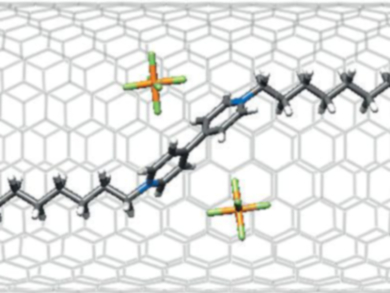Single-walled carbon nanotubes (SWNTs) are typically produced as a mixture of semiconducting and metallic SWNTs. This hampers their application in semiconducting technologies because metallic SWNTs would short-circuit devices. Emilio M. Pérez, Enrique Burzurí, Ciudad Universitaria de Cantoblanco, Madrid, Spain, and colleagues have developed a simple non-covalent approach to turn metallic SWNTs into high-quality semiconductors.
The team filled the cavities of metallic SWNTs with organic salts by directly mixing open-ended SWNTs with semi-saturated viologen solutions. The resulting viologen@SWNT products (segment pictured) are remarkably stable and can be aligned between two metallic electrodes using dielectrophoresis. Electrical measurements show that the initially metallic SWNTs become semiconducting upon encapsulation of viologens, with a notable on–off current ratio of around 106, and a field-effect mobility of about 600 cm2/Vs.
The metallic-to-semiconducting conversion is remarkably challenging and had previously only been achieved by carbon atom substitution, which dramatically modifies the structure of the tubes. The team’s results represent an entirely new strategy to open the band gaps in carbon nanomaterials.
- Band gap opening in metallic single-walled carbon nanotubes by encapsulation of an organic salt,
Belén Nieto-Ortega, Julia Villalva, Mariano Vera-Hidalgo, Luisa Ruíz-González, Enrique Burzurí, Emilio Manuel Pérez,
Angew. Chem. Int. Ed. 2017.
DOI: 10.1002/anie.201705258

![Synthesis of [c2]Daisy Chains via Mechanochemistry](https://www.chemistryviews.org/wp-content/uploads/2025/04/202504_RotaxanesWithSolidStateMechanochemistry-125x94.png)

